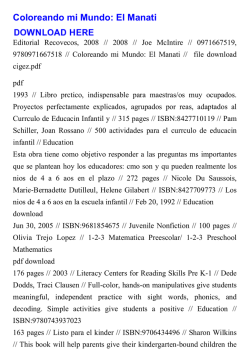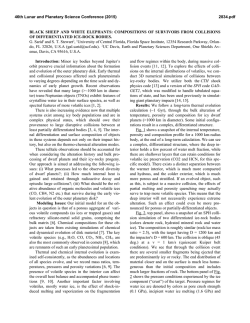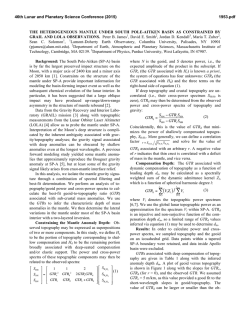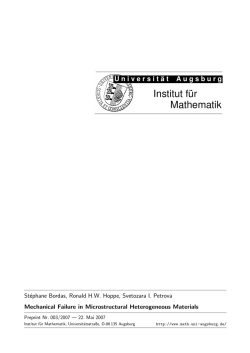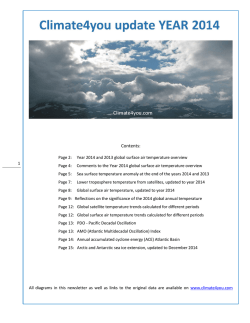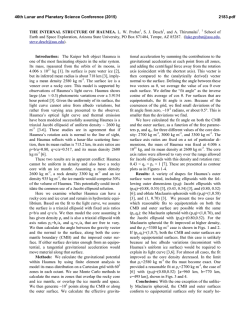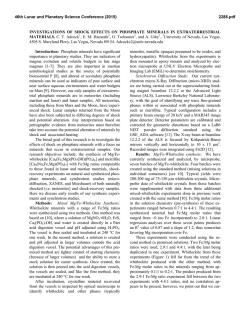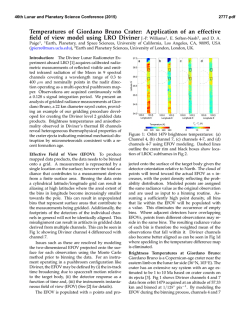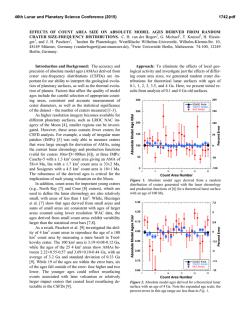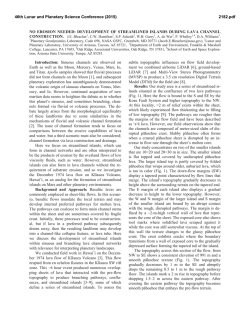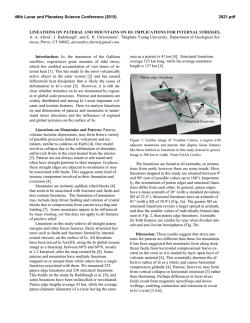
The Subsurface Structure of the Compton - USRA
46th Lunar and Planetary Science Conference (2015) 2185.pdf THE SUBSURFACE STRUCTURE OF THE COMPTON-BELKOVICH THORIUM ANOMALY AS REVEALED BY GRAIL. J. C. Jansen1, J. C. Andrews-Hanna1, Y. Li1, J. Besserer2, S. Goossens3, J. W. Head III4, W. S. Kiefer5, P. J. McGovern5, J. M. Soderblom6, G. J. Taylor7, M. A. Wieczorek8 and M. T. Zuber6, 1Department of Geophysics, Colorado School of Mines, Golden, CO 80401, [email protected], 2Laboratoire de Planétologie et Géodynamique de Nantes, Université de Nantés, France, 3Center for Research and Exploration in Space Science and Technology, University of Maryland, Baltimore, MD 21250, 4Department of Earth, Environmental and Planetary Sciences, Brown University, Providence, RI 02912. 5Lunar and Planetary Institute, Houston, TX 77058, 6Department of Earth, Atmospheric and Planetary Sciences, Massachusetts Institute of Technology, Cambridge, MA 02139, 7 Hawaii Institute of Geophysics and Planetology, University of Hawaii, Honolulu, HI 96822. 8Institut de Physique du Globe de Paris, Université Paris Diderot, 75013 Paris, France. Introduction: The Compton-Belkovich region on the lunar highlands (Fig. 1) was first identified as a thorium-rich area based on Lunar Prospector GammaRay Spectrometer data [1]. Subsequent workers suggested that the high thorium anomaly in the ComptonBelkovich area is associated with silicic volcanism, possibly caused by KREEP-rich intrusions within the crust [2,3,4]. Figure 1. Cylindrical projection of LOLA [5] topography in km, farside centered. The black box indicates the location of the Compton-Belkovich region expanded in Fig. 2. Figure 2. A) Topography (km), B) free-air gravity (mGal), C) Bouguer gravity (mGal), and D) Thorium concentrations (ppm) of the Compton-Belkovich high thorium region. The black box is the Compton-Belkovich area, the Humboldtianum basin is labeled H. Compton-Belkovich is observed in Lunar Oribiter Laser Altimeter (LOLA) data [5] to be characterized by average topographic relief that is approximately 1.6 km below its surroundings. Gravity data from the Gravity Recovery and Interior Laboratory (GRAIL) mission [6] now reveal a positive Bouguer gravity signature associated with the feature that is approximately 155 mGal greater than the surroundings (Fig. 2c). Here we use three-dimensional inverse modeling [7] of the Bouguer gravity to investigate the subsurface structure of Compton-Belkovich. We test the hypothesis that both the observed gravity and topography are the results of the loss of pore space in the crust caused by thermal annealing due to an increase in temperature from the high concentrations of heat producing elements present within the crust at this location. Methods: We used the program GRAV3D [8,9], which generates a three-dimensional density model based on the observed gravity data. The model minimizes an objective function that relates the data misfit and the model smoothness with a regularization parameter [7]. As input, we used the Bouguer-corrected GRAIL gravity data with a low-pass cosine taper applied between degrees 480 and 500. The model was used to predict density anomalies to a depth of 60 km, which is a little deeper than the base of the crust in this area [10]. The resulting three-dimensional density model was then interpreted under the assumption that all the density variations arise purely due to changes in porosity, assuming an initial bulk density of 2550 kg/m3 and an initial porosity of 12% [10]. Results and interpretations: The best-fit density model predicts a broad diffuse positive density anomaly beneath Compton-Belkovich, with a typical density excess of ~150 kg m-3 (Fig. 3). The diffuse nature and low magnitude of the predicted density anomalies are not consistent with the uplift of the crust-mantle interface as might occur beneath an ancient impact basin. In contrast, the mantle uplift below the nearby Humboldtianum basin is characterized by a sharply defined positive density anomaly with a magnitude of 320 kg m-3, consistent with the expected density contrast between the mantle and crust [10]. Furthermore, crater counts suggest this area to be Copernican in age [2]. Higher densities could also be the signature of compositional variations as could arise from magmatic intru- 46th Lunar and Planetary Science Conference (2015) sions in the lower crust. KREEP-rich intrusions may contribute to the gravity, but cannot explain the observed topographic depression. We now consider the possibility that both the positive density anomaly and the topography are results of the thermal annealing of the pore space caused by the enhanced concentrations of heat-producing elements in the crust. However, the observed Th concentration may be a result of a surficial volcanic deposit, and the concentration as a function of depth is poorly constrained [2]. Thus, here we simply test whether loss of porosity can explain the observed gravity and topography. We used the density model to calcuate the corresponding changes in porosity (Fig. 3). The model indicates that the gravity can be explained by a decrease in porosity by about ~6% relative to the surrounding terrain. This porosity decrease is less than typical crustal porosities determined by GRAIL [10,11], which supports the plausibility of this interpretation. From the inversion results, we calculated how much elevation change would result from the decrease in porosity. We consider the extreme case in which all of the porosity decreases resulted in a lowering of the topography (Fig. 4). The total change in elevation due to the changes in porosity is approximately -1.7 km. This is comparable to the observed relief of -1.6 km, and also matches the shape of the observed depression. Figure 3. A) Horizontal cross-sections of the density and porosity models at 30 km depth, black line indicates where the vertical cross section is taken. The black box is the location of Fig. 4. B) A vertical cross section of the models. We next considered different porosity models based on previous GRAIL analyses, assuming either linear or exponential porosity profiles [11]. The linear porosity profile uses a surface density of 2350 kg m-3, a density gradient of 30 kg m-3 km-1, and a grain density of 2917 kg m-3. The exponential porosity profiles use a density contrast between fractured surface materials and unfractured rock of 600 kg m-3, and a density increase depth scale of either 15 or 28 km. 2185.pdf In the case of the linear porosity profile, integrating the total loss of porosity throughout the crust would result in surface subsidence by 1.8 km, which is greater than the observed relief. The observed 1.6 km depression could result from the loss of all porosity below 1.4 km depth. For the exponential porosity profiles, the total elevation change resulting from the loss of all porosity would be 2.4 or 7.1 km for the two scale depths. The observed depression could be produced by the loss of all porosity below 5.2 or 37.3 km depth. Figure 4. Total elevation change associated with changes in porosity, zoomed in on the Compton-Belkovich area. Conclusions: The results from the inverse modeling show a diffuse broad positive density anomaly under Compton-Belkovich, which we interpret to be at least in part a result of thermal annealing of the pore space. The predicted density contrast is equivalent to the loss of 6% porosity in the lower crust relative to surroundings. The predicted density anomalies and the observed topographic relief are consistent with GRAIL-derived porosity models. The predicted changes in porosity are upper bounds, since we have not included the effects of high density KREEP-rich intrusions within the crust. Similar annealing of the pore space has been suggested beneath the Marius Hills [12]. The magnitude and diffuse nature of the density anomaly are inconsistent with the mantle uplift beneath an ancient impact basin. We cannot, however, exclude the possibility that an ancient impact may have been responsible for the Th-anomaly in the first place, and that the basin itself relaxed away. These results may also have implications for the gravity and topography of the Procellarum KREEP terrane. References: [1] Lawrence D. J. et al. (1999) GRL, 26, 2681-2684. [2] Elphic R. C. et al. (2000) JGR, 105, 2033320345. [3] Lawrence D. J. et al. (2003) JGR, 108, 5102. [4] Jolliff B. L. et al. (2011) Nature Geosci., 1212. [5] Smith D. E. et al. (2010), GRL, 37, L18204. [6] Zuber M. T. et al (2013) Science, 339, 668-671 [7] Jansen J. C. (2014) LPS XLV Abstract #2730. [8] Li Y. and Oldenburg D. (1996) Geophys., 6, 394-408. [9] Li Y. and Oldenburg D. (1998) Geophys., 63, 109-119. [10] Wieczorek M. A. (2013) Science, 339, 671-674. [11] Besserer J. (2014) GRL, 41, 57715777. [12] Kiefer W. S. (2013) JGR 118, doi:10.1029/ 2012JE004111.
© Copyright 2026
